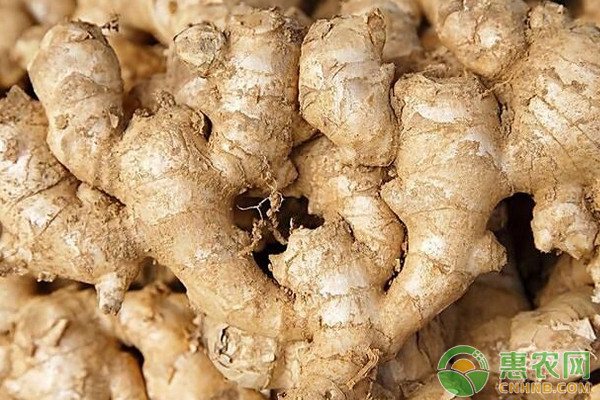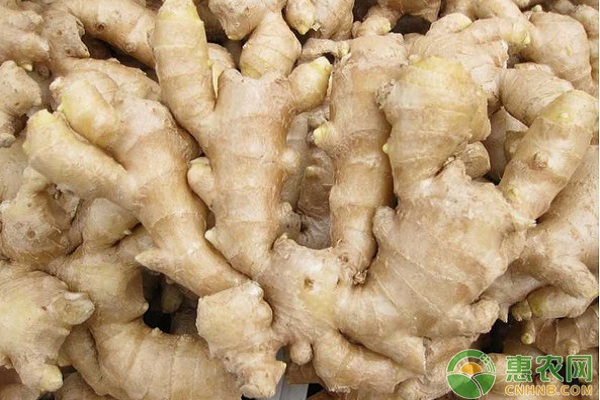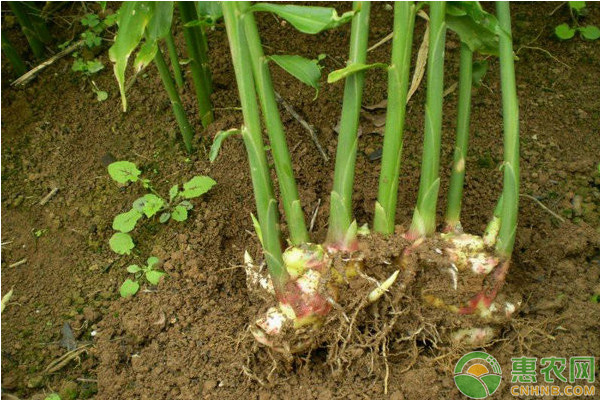Cultivation techniques of turmeric and cultivation of pests and diseases
In general, cultivated ginger is suitable for deep, loose, fertile, well-drained soil. The growth cycle of ginger is 6 months, and the accumulated temperature during the whole growth period is 5000 °C. Ginger likes warm and humid climate conditions, is not resistant to low temperature frost, avoids continuous cropping. Like weak light, under strong light, the leaves are easy to wither and turn yellow, and the production is shaded. However, the requirements for the length of sunshine are not strict. The fleshy roots of the plants are shallow, the roots are not developed, and the amount of fertilizer needed is relatively large. In addition to the application of the base fertilizer, the topdressing should be timely in different periods. Let's take a look at the key points of cultivation techniques for turmeric.

1 Fertilization and preparation
Before cultivating the land, spread 12 m3 of chicken manure and 8 m3 of high-quality decomposed cow dung on the surface, and use a rotary tiller to deepen 20 to 30 cm to mix the soil and fertilizer evenly to ensure loose soil and good ventilation. Eli root growth and development.
2 selection
Choose excellent varieties that are resistant to storage, good quality, high yield, and strong resistance. Choose a full, fat, shiny surface, no mechanical damage and no pests and diseases.
3 ginger treatment
3.1 Sunning ginger
Wash the ginger on the 20 to 30 days before sowing, and avoid damage to the ginger when cleaning. Choose to turn the ginger on a sunny day for 1 to 2 days. In the afternoon, the house was taken back to avoid frostbite. If the sun is strong, it should be properly shaded to prevent exposure to strong light.
3.2 sleepy ginger
After the ginger is dried, the ginger is covered with a straw curtain. The temperature is kept between 11 °C and 15 °C. After 2 days of stacking, the inferior ginger species with dry wrinkles, soft and brown are eliminated.

3.3 germination
In the first ten days of April, the temperature is changed to germination. The ginger is layered in the basket, placed on the farmer's coffin, and covered with straw curtain. The temperature is controlled at 21 °C ~ 29 °C. After more than 20 days, when the young When the bud length grows to about 1 cm, the ginger is taken out for sowing.
3.4 Cut ginger
Cut the ginger into 50 to 100 grams of ginger with a knife. The weight is best and uniform. One or two strong shoots are kept on each ginger, and the remaining shoots are all removed.
3.5 soaking and disinfecting
Soak seeds with grass ash solution for 30 minutes, or soak them with 1% Bordeaux solution for 30 minutes, or soak them with 50% carbendazim solution for 30 minutes, or soak them with 1% lime water for 30 minutes, then remove the disinfectant and put it on a clean ground. Dry and prepare.
4 sowing
4.1 Sowing date
Between mid-April and early May, 5 to 7 cm of ground temperature is stable at above 16 °C.
4.2 Seeding density
There are 5,000 plants per acre in fields with high soil fertility, 5,500 plants per mu in fields with moderate soil fertility, and 6,000 plants per acre in fields with poor soil fertility. Under the same fertility, large pieces of ginger are planted in a thin manner, and small pieces of ginger are densely planted.
4.3 Seeding method
Lishu County generally adopts the method of ridge and ridge cultivation, and opens the planting ditch according to the line spacing of 50-60 cm. The base fertilizer is evenly applied, and the bottom water is poured. After the water is infiltrated, the ginger buds of the ash ash are turned upwards, according to 16~ The plant spacing of 22 cm was placed in the ditch and covered with soil 4-6 cm. The herbicide was sprayed on the field.
5 Field management
5.1 Shade
When the rate of emergence of ginger in the greenhouse reaches 50%, a layer of shading net should be covered on the cold shed to avoid strong light. In the first ten days of August, the shading net must be removed in time.

5.2 cultivating soil
During the growing period, the cultivating soil should be cultivated for 3 to 4 times. Due to the lack of roots in the early growth stage, the roots should be properly ploughed, and the roots must be shallowly ploughed in the middle and late growth stages to avoid root damage. Cultivate the soil once every half month.
5.3 Temperature control
From cultivation to emergence, you can take a small arch shed to control the ground temperature at 20 °C ~ 30 °C, and remove the small arch shed when the seedling grows to 20 cm. The temperature in the cold shed throughout the growing season is controlled between 20 ° C and 39 ° C.
5.4 Water and fertilizer management
When the seedlings reach 80%, water is poured once. When entering the vigorous growth period, water is poured every 4-7 days depending on the sensation.
The first top dressing time showed small branches when the ginger seedlings grew to 30 cm; the second top dressing time was in the third flood season; the third top dressing time was in the rhizome expansion period.
6 pest control
6.1 Agricultural control
It is carried out for more than 3 to 4 years with the cruciferous rotation; avoid continuous cropping or stalking for tomato, eggplant and other solanaceous crops; choose a loamy soil with good topography and no standing water.
6.2 Disease prevention
6.2.1 Ginger disease can be prevented by immersion and disinfection before sowing. If it is later, it should be sprayed 2~3 times with 50% dexamethasone 1000 times.
6.2.2 Spraying 70% thiophanate-methyl WP 1000 times solution or 64% cream · Mn-Zn WP 500-800 times solution at the initial stage of ginger spot disease, spraying once every 8 days, continuous spraying 2 ~3 times.
6.3 Pest Control
6.3.1 After the end of land preparation, the golden worms shall be sprayed with nematode liquid or worm liquid to prevent the golden worms before planting.
6.3.2 In the 2nd instar larva stage, the small ground tiger is sprayed with 2.5% cypermethrin emulsifiable concentrate 3000 times or 50% phoxim emulsifiable concentrate 1000 times.
7 Harvesting and seeding
The general harvest time is mid-October. When the plants are yellow, the roots are harvested when they are full and full. Before harvesting, the soil should be fully moistened with small water. After the soil is slightly dried, the plants are pulled out, the stems are cut at 2 cm above the base of the stem, and the roots on the ginger are removed, and then stored.
The above is all about the cultivation technology of turmeric, welcome all the friends of the farmers to come to Huinong.com to learn more!
An active substance is the main active ingredient in a drug. Take a simple aspirin for example. Acetyl salicylic acid is synthesized through chemical process and purified to a specified purity. The synthesis of acetyl salicylic acid is made by adding various excipients, such as fillers, adhesives, disintegrating agents, etc., and then pressing it into tablets. The production of apis is generally either pure chemical synthesis, biological fermentation, or semi-synthesis, with biological fermentation followed by extraction followed by synthesis. Not all pharmaceutical enterprises make API by themselves, and many manufacturers do not have the scale to produce API. Even if there is large-scale production, the cost of production may be much higher than that of procurement. Therefore, most manufacturers buy bulk drugs, and then make preparations, so that the production of drugs can be completed without a very large scale. At present, China and India have become the two largest API producers in the world. Many European and American pharmaceutical companies, even some of their own original drugs, will give up the production of API as the patent expires and the market matures, and turn to purchase apis from China and India,API production generally go through laboratory, generated through laboratory bottle container canister, taking after successful, pilot magnification, which is to enlarge the quantity of the production, then no problem tends to be faced with a lot of small scale experiment, a very simple example, the heating process, due to the relatively small amount in the laboratory, uneven heating cases is less, But if it is scaled up to a few tons of pot, at this time the heating may be not hot in this place, where the paste pot, at this time you need to stir, but the speed of mixing is appropriate, this process needs to calculate or grope. Finally from the pilot test, and then to the formal production, the volume of further amplification, and will face a lot of new problems. Therefore, although some drugs are generic, the research and development of the whole process from small test, pilot test to the final mass production is indispensable, so even generic drugs have very high research and development costs.
api meaning,api products to buy,best api products,cheap api products,best buy products api,best api products
Shaanxi YXchuang Biotechnology Co., Ltd , https://www.peptidenootropics.com